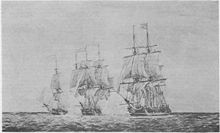Six Weeks on the U.S.S. Hancock
After all, privateer captains didn’t owe Manley any obedience. Capt. John Grimes on the American Tartar, the largest of those ships, headed across the Atlantic and in July captured several British vessels off the Shetland Islands and the coast of Norway. The little ones stuck to the New England coast.
In contrast, Capt. Hector MacNeill on the Boston was in the Continental Navy under orders to stick with Manley. Their target would be British fishing vessels and unaccompanied merchant ships in the north Atlantic.
Within days the Hancock and Boston caught a prize: a small brig carrying cordage and sailcloth.
On 30 May the two frigates spotted some military transports. Unfortunately for Manley, those ships were guarded by H.M.S. Somerset, the same 70-gun warship that had sat in the Charles River in the spring of 1775 (and that wrecked on Cape Cod in the fall of 1778).
The Somerset went after Manley’s Hancock, which had only half as many cannon. MacNeill’s Boston then closed on the more lightly armed transport ships. That forced the Somerset to break off and return to protect the convoy, allowing both Continental ships to sail away intact.
On 7 June, Manley and MacNeill’s frigates chased another promising ship. The Hancock caught up first, and Manley discovered his quarry was the Fox, a British privateer carrying 28 guns. The two ships fought for half an hour. Then the Boston arrived. Between them, Manley and MacNeill forced the Fox’s surrender. Its mainmast and wheel were shot off, four men killed and eight wounded.
On board the Hancock, a black sailor named John Brick “on fortunetly Lost his Left Legg” in this fight, as a second lieutenant attested. Dr. Samuel Curtis thus did his first major operation as a combat surgeon.
Capt. Manley took a few days to make repairs to the Fox. He put a prize crew aboard and divided its crew as prisoners between the Hancock and Boston. This three-vessel Continental fleet then captured a coal sloop off Cape Sable Island at the southwestern tip of Nova Scotia.
By Sunday, 6 July, Manley’s four ships were near Halifax, a major British base. Two large warships came out of the harbor. Capt. Manley turned and headed back toward New England as fast as his fleet could sail.
TOMORROW: Commander over the Rainbow.




